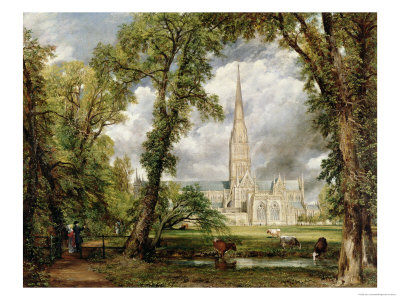Salisbury Cathedral from the Bishop's Grounds is one of John Constable‘s most noted landscape painting. This 1823 painting depicts the image of Salisbury Cathedral, the imposing medieval cathedral.
Constable started work on the painting in 1820, on the commission of John Fisher, the bishop of Salisbury, and his close friend. He started by making a series of oil sketches, on the basis on which he executed his final composition. True to Constable’s overriding theme of making landscape portraits, he zeroed in on a view from the bishop’s garden.
Typical of Constable’s style, he looks to the cathedral through the woodland, making a rich description of the tame woodland, and the green pastures, complete with country gentry getting on with their work, and the cattle grazing.
The attention to detail in the imagery is striking. The extremely exquisite presentation of the windows, buttress, and the other finer features of the architectural masterpiece that is the Salisbury cathedral is telling on the painter’s skills.
Equally noteworthy is the vivid presentation of the rich landscape around the cathedral, complete with the trees, water meadows, a rich pasture with cattle, and clouds, in a natural way.
The arch of the trees encompassing the cathedral spire and frames in a perfect manner, and the light shades of the cathedral add a magical touch to the painting. The painting is held in high regard for depicting the quintessential British landscape in its full vigour, and is a magnificent exposition of country life as it existed at the time.
The gentlemen with their backs turned, and pointing to the building with his walking cane, depicted on the bottom left, is Dr Fisher, the painter’s patron. Constable painted a dark cloud over the cathedral in the initial version, but on his patron’s objection, painted a more serene sky in a replica version. The tree canopy is another addition in the replica version.
Technically, the portrait is noteworthy for the artists' innovative use of the thick "impasto" brushstroke, which allowed him to create depth and movement, and also adds a greater degree of realism. The painting is also noted for the striking use of natural colours. An example is the use of red to compliment the overtly green landscape, and also the effective use of deeper tones and contrast.
Salisbury Cathedral from the Bishop’s Grounds was exhibited at the Royal Academy, London, in 1823. The replica version now resides at the Frank Collection in New York City. Another smaller version of the portrait, made available for John Fisher, is available at the Huntington Library in San Marino, California. The earlier version, from the oil painting models now reside at "Sao Paulo Museum of Art" in Sao Paulo.
Though several artists have made exquisite paintings on the imposing Salisbury cathedral, Constable’s portrait is arguably the most successful effort, and by far the most popular. Salisbury Cathedral was central to the 18th-century community to which Constable belonged. Nevertheless, Constable was also inspired by the works of some earlier greats, such as Thomas Gainsborough and Claude Lorrain. These artists had a profound impact and influence on the development of Constable’s art.




